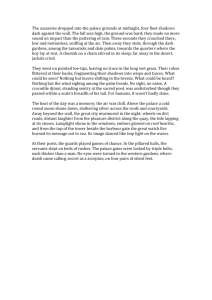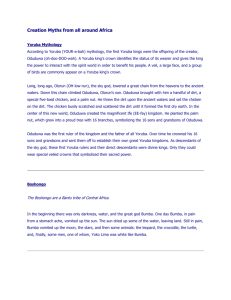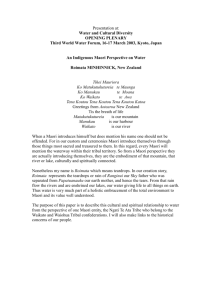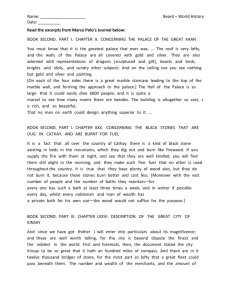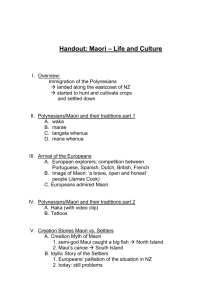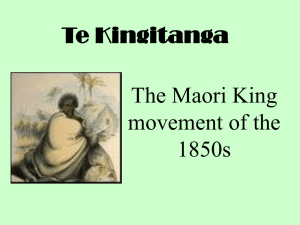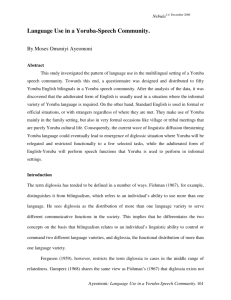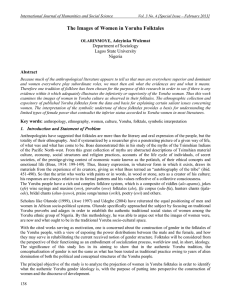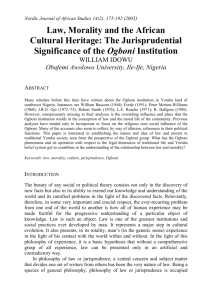0495094870_257849
advertisement
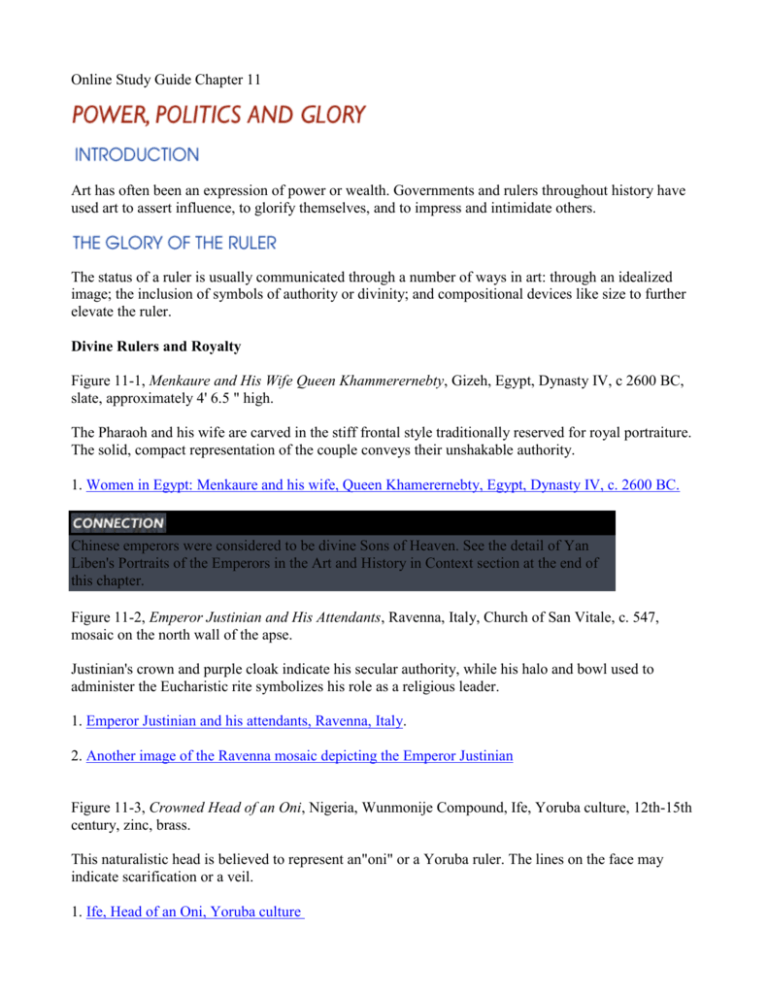
Online Study Guide Chapter 11 Art has often been an expression of power or wealth. Governments and rulers throughout history have used art to assert influence, to glorify themselves, and to impress and intimidate others. The status of a ruler is usually communicated through a number of ways in art: through an idealized image; the inclusion of symbols of authority or divinity; and compositional devices like size to further elevate the ruler. Divine Rulers and Royalty Figure 11-1, Menkaure and His Wife Queen Khammerernebty, Gizeh, Egypt, Dynasty IV, c 2600 BC, slate, approximately 4' 6.5 " high. The Pharaoh and his wife are carved in the stiff frontal style traditionally reserved for royal portraiture. The solid, compact representation of the couple conveys their unshakable authority. 1. Women in Egypt: Menkaure and his wife, Queen Khamerernebty, Egypt, Dynasty IV, c. 2600 BC. Chinese emperors were considered to be divine Sons of Heaven. See the detail of Yan Liben's Portraits of the Emperors in the Art and History in Context section at the end of this chapter. Figure 11-2, Emperor Justinian and His Attendants, Ravenna, Italy, Church of San Vitale, c. 547, mosaic on the north wall of the apse. Justinian's crown and purple cloak indicate his secular authority, while his halo and bowl used to administer the Eucharistic rite symbolizes his role as a religious leader. 1. Emperor Justinian and his attendants, Ravenna, Italy. 2. Another image of the Ravenna mosaic depicting the Emperor Justinian Figure 11-3, Crowned Head of an Oni, Nigeria, Wunmonije Compound, Ife, Yoruba culture, 12th-15th century, zinc, brass. This naturalistic head is believed to represent an"oni" or a Yoruba ruler. The lines on the face may indicate scarification or a veil. 1. Ife, Head of an Oni, Yoruba culture To see the range of styles in African art, contrast the naturalistic quality of the Crowned Head of an Oni with the more abstracted style of the Reliquary Guardian Figure (Figure 10.20, page 262) 1. Reliquary Guardian Figure Yoruba leaders today are identified by such headgear as the Great Beaded Crown of the Orangun-Ila, in Figure 14.25 (page 387). These contemporary crowns are ancient forms that may date back to those worn by the early onis. 1. Photo Essay on Yoruba Jayavarman's likeness may have been the model for the Buddha faces on the Temple of Bayon at Angkor Wat (Fig. 6.16, page 129). Figure 11-4, Jayavarman VII, Cambodia, province of Siemreap, Angkor region, late 12th or early 13th century CE. Bayon style. Sandstone head, 41 x 25 x 31 cm. 1. Jayavarman VII Objects of Royalty and Prestige Rulers have always surrounded themselves with symbols of power. While no specific material or object universally denotes status, the use of precious materials and high levels of craftsmanship is common. The objects themselves can possess divine significance. Figure 11-5, Cloak and Feather Hat, Hawaii, 18th century. Museo de America, Madrid, Spain. 1. Hawaiian Artifacts See Moctezuma's Headdress in Figure 11.32 (page 301), to compare Hawaiian and Aztec feather work. Figure 11-6, Mesquakie Bear Claw Necklace, Tama, Iowa, USA, otter pelt, grizzly claws, glass beads, silk ribbon, 16 1/4 " long, 14 1/4" wide, 3 1/8 " high. The highly prized grizzly bear claws from this necklace impart prestige onto the owner. 1. Mesquakie Bear Claw Necklace Contemporary Political Leaders Today's rulers rarely claim divine descent. Mass media has changed the way images of rulers are distributed. Figure 11-6, Scenes from the film Triumph of the Will, Leni Riefenstahl, Germany, 1934. The Nazi propaganda film documented a six day rally celebrating Adolf Hitler at Nuremberg. Director Reifenstahl created the first media politician of the modern age. 1. Numerous Scene Shots from the film Triumph of the Will, by Leni Riefenstahl Palaces Palaces are the official residences of king, emperors, and high-ranking religious leaders. They are the visual embodiments of the power of the state. Some common traits shared among palaces are their grand size, height, lavish decoration, and prominent displays of art. Figure 11-8, Lamassu, Khorsabad, Iraq, 720 BCE. Limestone, 14' high. 1. Lamassu (bull-man) 2. Another Photo of a Lamassu We will look at other fantastic animals, and the reasons humans invented them, in Chapter 15, Nature, Knowledge, and Technology. Figure 11-9, Persepolis, general view, Persia (Iran) c. 559-330 BCE. Achaemenid. The Achaemenid palace took fifty years to build and was destroyed by Alexander the Great. The Royal Audience Hall once held up to 10,000 guests. 1. Reconstruction drawing of the exterior of the Royal Audience Hall Figure 11-10, Palace at Palenque, Chiapas, Mexico, Mayan culture, 514-784 AD. The abandoned palace once served as a center for religion, art, and astronomical studies. 1. Palace at Palenque, Mayan, Chiapas, Mexico, AD 514-784 2. Front view of the Palace at Palenque Figure 11-11, Imperial Throne Room in the Hall of Supreme Harmony, Forbidden City, Beijing, China. The interior of the Imperial Throne Room is lavishly decorated. Symmetry plays an important part in following Confucian and Daosit principles. 1. View exquisite details from the Imperial Throne Room of the Hall of Supreme Harmony 2. Imperial Throne Room Other Chinese examples of ambitious royal building projects are the Soldiers from Pit 1 (Figure 10.8, page 251) from the tomb of Qin emperor Shi Huangdi, and the Great Wall of China (Figure 11.20, page 292). Figure 11-12, Hall of Mirrors, Jules Hardouin Mansart and Charles Le Brun, Versailles, France, c. 1680. The Hall of Mirrors used mirrors, windows, candelabra, and jeweled decorations to produce a dazzling optical effect. Its elaborate style of ornamentation is called the "Louis XIV style." (See also figures 3.9) 1. Panorama of the Hall of Mirrors at Versailles, from the ChateauVersailles website 2. Information about the Hall of Mirrors at Versailles At Versailles, Louis XIV stripped the nobility of their power, so they occupied their time in games of romance and intrigue, as in Fragonard's The Swing (Figure 14.24, page 386). Figure 11-13, Palace Sculpture, Olowe of Ise, at Ikere, Nigeria, Yoruba culture, wood and pigment, 1910-14, 60 7/8" x 13 1/4". The senior queen stands behind the diminutive king. Yoruba women are revered for their ability to procreate, and the royal line is traced through the female lineage. (See also figure 4.2) 1. The Works of Olowe of Ise 2. Bowl with Figures, sculpture by Olowe of Ise Seats of Government As symbols of the state, social and political influences shape the architecture of government buildings. Figure 11-14, Houses of Parliament, Charles Barry and A.W.N. Pugin, London, UK, 1840-1860, 940' long. The Gothic Revival in Western architecture, coinciding with England's nationalist cultural climate, contributed to the design of its Houses of Parliament. 1. Houses of Parliament. Architects Charles Barry and A.W.N. Pugin, 1840-1860. 2. View of the Houses of Parliament Chartres Cathedral (Figure 9.36, page 233) and the Chapel of Henry VII in Westminster Abbey (Figure 10.17, page 259) are two examples of Gothic architecture, which inspired the design of the Houses of Parliament. Figure 11-15, Te Papaiouru Marae, Maori Meeting House, Ohinemutu Maori Village, Roturua, North Island, New Zealand, late 19th century. The Maori structure serves as a three-dimensional genealogical metaphor. Maori cultures place great importance on genealogy, because it tied them back to powerful ancestors and was the basis for determining land holdings. The meeting house became the body of the ancestor. 1. Maori Meeting House in New Zealand 2. Detail of carved poles from Maori meeting houses 3. Carvings on the wall of a Maori meeting house Monuments Monuments publicly commemorate a person, event, era, or culture. They exist in between sculpture and architecture, and are usually imposing in scale. The Portrait of George (Figure 12.29, page 328) is a monument to slain San Francisco mayor George Moscone. Another example is the Monumental Heads from the Easter Islands (Fig. 3.23, page 70). 1. Monumental heads at Easter Island Figure 11-16, Arch of Titus, Rome, Italy, marbled faced on concrete wall, 81 AD, 50' high, 40' wide. The Arch of Titus celebrates the military victories of the Roman leader and his apotheosis (rise to divinity). 1. Another view of the Arch of Titus 2. Spoils of Jerusalem, relief panel from the Arch of Titus War is part of nearly all cultures. Art Depicting Warriors Depictions of warriors have been found as far back as cave paintings. Warriors are usually depicted with imposing statures, specialized armor, and they wear impassive or fierce expressions. Figure 11-17, Tula Warrior Columns, Mexico, Toltec culture, 900-1000 AD, 16 to 20' high. Their sheer size, uniform appearance, and stiff poses give the Tula Warriors Columns an air of impenetrable might. 1. Tula Warrior Columns 2. The"Atlantids" at Tula, Toltec culture Figure 11-18, Equestrian Monument of Bartolomeo Colleoni, Andrea del Verrocchio, Venice, Italy,1483-88, bronze, 15' high. The Italian mercenary's fierce skill as a soldier is conveyed primarily through his control of his majestic horse and his scowling expression. 1. Equestrian Monument of Bartolomeo Colleoni by Andrea del Verrocchio Compare the Equestrian Statue of Marcus Aurelius (Fig. 1.2) for a non-warrior image of a ruler on horseback. Figure 11-19, Plaque with Warrior and Attendants, Nigeria, Benin culture, c 17th or early 18th centuries, brass, 19 1/4" high. Benin bronze plaques were commissioned by the king or"Oba" and functioned as public reminders of the Oba's authority. The warrior's royal status is signified by his size and the leopard motif on his regalia. 1. Benin Warrior Plaque from the Guggenheim African collection Fortifications, Armor, and Weapons Architecture and paraphernalia for war need to function offensively and defensively. A warrior's armor is meant to protect, impress, and intimidate through visual means as well as serving as physical armor. Like armor, weapons can be works of art that possess symbolic power. Figure 11-20, The Great Wall, China, construction began in the Chin Dynasty 221-206 BC, with major work accomplished in the Ming Dynasty 1368-1644. brick faced, average height 25 ', 1,500 miles long. The Great Wall is a source of national pride, testifying to the awesome power of collective human will. It is considered on the"wonders of the world." 1. Images and information about the Great Wall of China War Scenes Art can affect public opinions about war and artist throughout time have documented the events of wars. The history of art about war has tended to glorify warfare. With the development of photography and film during the twentieth century, we have seen the appearance of more art that has adopted a critical stance on war. Figure 11-21, Palette of King Narmer, Egypt, c 3100 BC, slate, 25" high. This palette may have been used to mix eye makeup. The relief shows King Narmer of Upper Egypt conquering Lower Egypt. 1. Front of the Palette of Narmer, from the McClung Museum exhibition 2. View the entire McClung exhibit,"Ancient Egypt: The Eternal Voice," and see the other side of the Palette of Narmer Figure 11-22, The Burning of the Sanjo Palace, from the Heiji Monogatari, (detail) Japan, Kamakura period, late 13th century, hand scroll, ink and color on paper, 16 1/4" high, 22' 9" overall length. The Kamakura era tale of two feuding clans is illustrated in a 23 foot scroll painting. Strong contrasts imbue the fire scene with the drama and confusion of warfare. 1. The Burning of the Sanjo Palace 19th Century Battle Scenes Figure 11-23, Dead Confederate Soldier with Gun, Matthew B. Brady or staff, USA, 1865, photograph. Brady's documentation of the Civil War made it the first war to be photographically recorded. Photography allowed the horrors of war to become part of the public record. Although photography claims an aura of objective truth, Brady carefully arranged his shots to maximize their aesthetic and emotional appeal. 1. “The Devil's Den," Matthew Brady Civil War Photos Figure 11-24, Battle of Little Big Horn, Red Horse, USA, Sioux culture, 1880. Art can present an alternative reading of war from that which is presented in media or in history books. General Custer's fall at Little Big Horn is depicted by a Sioux artist. 1. Chief Red Horse's Account of the Battle of Little Big Horn 2. FBI theft notice of Native American ledger drawings Twentieth Century Images of War Twentieth century images of war were dominated by photography and film. Images critical of war have become more prevalent. In Chapter 12, we will see several artworks effectively used in protest against war. Figure 11-25, The Battleship Potemkin, Sergei M. Eisenstein, Russia, 1925, film. Eisenstein's groundbreaking use of montage and camera angles recreated the horror of the 1905 Odessa Steps Massacre. 1. The Battleship Potemkin at IMDB Figure 11-26, Guernica, Pablo Picasso, Spain, 1939, oil on canvas, 11' x 28'8". Picasso denounced the annihilation of the Basque capital and its population at the hands of Franco and the Nazis. Guernica is regarded as one of the most powerful anti-war paintings ever created. 1. Picasso's Guernica, at the Reina Sophia Museum 2. Detail from Picasso's Guernica and information about the Spanish Civil War War Monuments and Memorials Figure 11-27, USA Marine Corps War Memorial, Felix W. Weldon, Arlington, Virginia, 1954, cast bronze. This popular monument commemorates the American deaths at the Battle of Iwo Jima. The sculpture is based on a photograph taken by Joe Rosenthal. 1. The Iwo Jima Memorial (“USA Marine Corps War Memorial") 2. Detail of the Marine Corps War Memorial Figure 11-28, Maya Ying Lin. Vietnam Veterans Memorial. Black granite, 492' long; height of wall at center 10'1". Washington, D.C., USA, 1982. 1. The Wall Website Figure 11-29, Eddie Adams. Brigadier General Nguyen Ngoc Loan summarily executing the suspected leader of a Vietcong commando unit. Saigon, South Vietnam, February 1, 1968. World Wide Photos. 1. Photographs of War In contrast with the volume of art about war, few works of art about peace exist. Art about Peace Ambrogio Lorenzetti's Allegory of Good Government contains a personification of peace and shows the prosperity that comes with peace. See also Figure 12.19. Figure 11-30, The Peaceable Kingdom, Edward Hicks, USA, 1780-1849, oil. The self-taught Quaker convert shares his vision of a utopian world of peaceable coexistence among all living creatures. William Penn's negotiation of a peace treaty with Native Americans is depicted in the background. 1. View another version of The Peaceable Kingdom by Hicks Peace Offerings and Peace Monuments Ara Pacis Augustae commemorated Augustus' success in subduing the civil wars between Spain and France. Sacrificial offerings, however, were made on this altar of peace. Figure 11-31, Ara Pacis Augustae, Rome, 13-9 BCE. Marble; outer wall, 34' 5” x 38' x 23'. 1. Front view of the ‘Altar of Augustan Peace' Figure 11-32, Moctezuma's Headdress, Aztec culture, Mexico, c 1319, Quetzal and Cotinga feathers. Moctezuma presented this extraordinary feather headdress to the Spanish conquistador, Cortés, in an effort to appease the invadors. 1. Moctezuma's Headdress Figure 11-33, Presentation Pipe Tomahawk, Ottawa, USA, c 1820, wood , inlaid metal. Presentation Pipe Tomahawk was designed exclusively for exchanging ceremonial peace offerings. 1. Two Presentation Pipe Tomahawks 2. View a rare ‘inlaid presentation pipe tomahawk'
